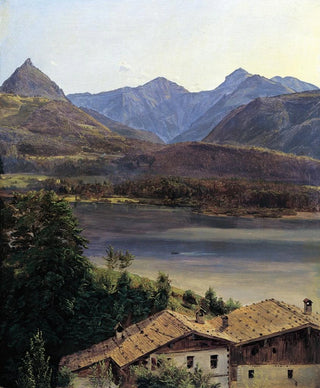Art print | Wolfgang Lake - Ferdinand Georg Waldmüller


View from behind

Frame (optional)
In the fascinating world of 19th-century Austrian painting, the art print "Lac Wolfgang" by Ferdinand Georg Waldmüller stands out for its emotional depth and technical mastery. This canvas, which evokes the serene beauty of alpine landscapes, invites the viewer to an immersive contemplation. The delicate nuances of the sky are reflected on the crystal-clear waters of the lake, creating a harmonious dialogue between nature and art. Waldmüller, with his keen sense of observation, manages to capture not only the light but also the soul of this enchanting place, offering a visual experience that transcends the simple landscape.
Style and uniqueness of the art print
Waldmüller's style is characterized by meticulous realism and particular attention to detail. In "Lac Wolfgang," he combines precise pictorial technique with poetic sensitivity. Every brushstroke seems to be a tribute to nature, and the vibrant colors used to depict the surrounding mountains and lush vegetation testify to his deep respect for the natural world. The composition of the art print, balanced and dynamic, guides the viewer's eye across the scene, inviting exploration of every corner of this idyllic landscape. Waldmüller succeeds in creating an atmosphere that is both peaceful and lively, where the viewer can almost hear the whisper of the wind on the lake's waters.
The artist and his influence
Ferdinand Georg Waldmüller, born in 1793, is often regarded as one of the pioneers of the realist movement in painting. His career, marked by an incessant quest for visual truth, led him to focus on everyday life and natural landscapes. Influenced by the romantic currents of his time, he was able to combine a realistic approach with poetic sensitivity, which allowed him to stand out in the art world. Waldmüller also had a significant impact on his contemporaries and subsequent generations, inspiring many artists to explore themes of nature and humanity with the same depth of emotion. His work, of which "Lac Wolfgang" is an emblematic example, continues to resonate in the current artistic landscape.

Matte finish

View from behind

Frame (optional)
In the fascinating world of 19th-century Austrian painting, the art print "Lac Wolfgang" by Ferdinand Georg Waldmüller stands out for its emotional depth and technical mastery. This canvas, which evokes the serene beauty of alpine landscapes, invites the viewer to an immersive contemplation. The delicate nuances of the sky are reflected on the crystal-clear waters of the lake, creating a harmonious dialogue between nature and art. Waldmüller, with his keen sense of observation, manages to capture not only the light but also the soul of this enchanting place, offering a visual experience that transcends the simple landscape.
Style and uniqueness of the art print
Waldmüller's style is characterized by meticulous realism and particular attention to detail. In "Lac Wolfgang," he combines precise pictorial technique with poetic sensitivity. Every brushstroke seems to be a tribute to nature, and the vibrant colors used to depict the surrounding mountains and lush vegetation testify to his deep respect for the natural world. The composition of the art print, balanced and dynamic, guides the viewer's eye across the scene, inviting exploration of every corner of this idyllic landscape. Waldmüller succeeds in creating an atmosphere that is both peaceful and lively, where the viewer can almost hear the whisper of the wind on the lake's waters.
The artist and his influence
Ferdinand Georg Waldmüller, born in 1793, is often regarded as one of the pioneers of the realist movement in painting. His career, marked by an incessant quest for visual truth, led him to focus on everyday life and natural landscapes. Influenced by the romantic currents of his time, he was able to combine a realistic approach with poetic sensitivity, which allowed him to stand out in the art world. Waldmüller also had a significant impact on his contemporaries and subsequent generations, inspiring many artists to explore themes of nature and humanity with the same depth of emotion. His work, of which "Lac Wolfgang" is an emblematic example, continues to resonate in the current artistic landscape.






